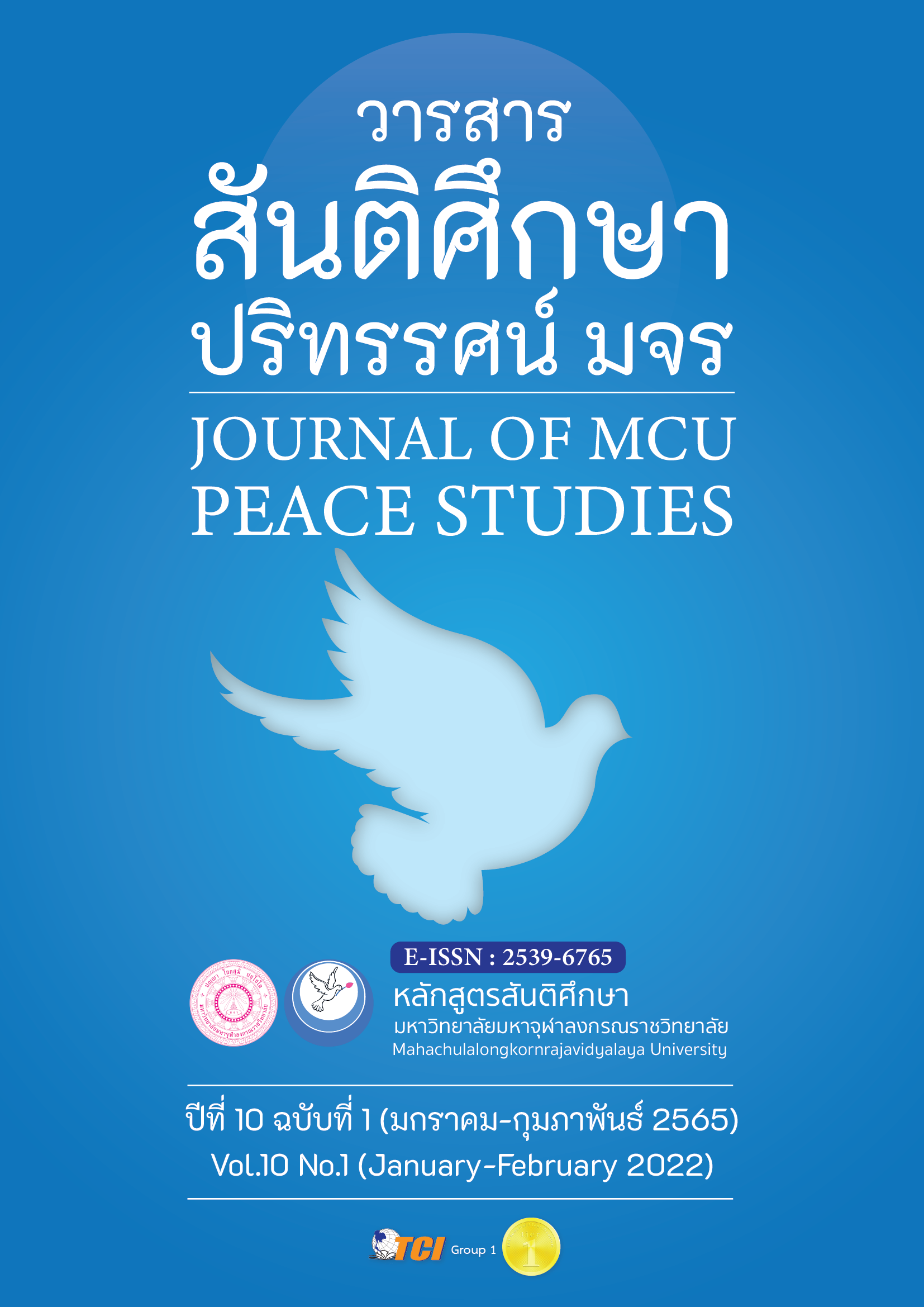การพัฒนาความคิดสร้างสรรค์ ของนักเรียนชั้นมัธยมศึกษาปีที่ 2 เรื่อง การแยกสาร โดยการจัดการเรียนรู้แบบสตีมศึกษาร่วมกับปรัชญาเศรษฐกิจพอเพียง
Main Article Content
บทคัดย่อ
บทคัดย่อ
บทความวิจัยนี้มีวัตถุประสงค์เพื่อ 1) สร้างแผนการจัดการเรียนรู้แบบสตีมศึกษาร่วมกับปรัชญาเศรษฐกิจพอเพียง เรื่อง การแยกสาร ของนักเรียนชั้นมัธยมศึกษาปีที่ 2 ให้มีประสิทธิภาพตามเกณฑ์ 80/80 2) เปรียบเทียบความคิดสร้างสรรค์ของนักเรียน ก่อนเรียนและหลังเรียน 3) เปรียบเทียบผลสัมฤทธิ์ทางการเรียนของนักเรียน ก่อนเรียนและหลังเรียน และ 4) ศึกษาความพึงพอใจของนักเรียนที่มีต่อการจัดการเรียนรู้แบบสตีมศึกษาร่วมกับปรัชญาเศรษฐกิจพอเพียง กลุ่มตัวอย่าง คือ นักเรียนชั้นมัธยมศึกษาปีที่ 2/4 โรงเรียนธาตุนารายณ์วิทยา ภาคเรียนที่ 2 ปีการศึกษา 2563 จำนวน 42 คน โดยการสุ่มตัวอย่างแบบกลุ่ม สถิติที่ใช้ ได้แก่ ค่าร้อยละ ค่าเฉลี่ย ส่วนเบี่ยงเบนมาตรฐาน และค่าสถิติทดสอบค่าทีแบบไม่เป็นอิสระต่อกัน ผลการวิจัยพบว่า 1) แผนการจัดการเรียนรู้แบบสตีมศึกษาร่วมกับปรัชญาเศรษฐกิจพอเพียง เรื่อง การแยกสาร ของนักเรียนชั้นมัธยมศึกษาปีที่ 2
มีประสิทธิภาพเท่ากับ 81.14/80.09 ซึ่งสูงกว่าเกณฑ์ 80/80 ที่กำหนดไว้ 2) ความคิดสร้างสรรค์ของนักเรียน หลังเรียนสูงกว่าก่อนเรียน อย่างมีนัยสำคัญทางสถิติที่ระดับ .01 3) ผลสัมฤทธิ์ทางการเรียนของนักเรียน หลังเรียนสูงกว่าก่อนเรียน อย่างมีนัยสำคัญทางสถิติที่ระดับ .01
4) ความพึงพอใจของนักเรียนที่มีต่อการจัดการเรียนรู้แบบสตีมศึกษาร่วมกับปรัชญาเศรษฐกิจพอเพียง อยู่ในระดับมากที่สุด
Article Details

อนุญาตภายใต้เงื่อนไข Creative Commons Attribution-NonCommercial-NoDerivatives 4.0 International License.
ทัศนะและความคิดเห็นที่ปรากฏในบทความในวารสาร ถือเป็นความรับผิดชอบของผู้เขียนบทความนั้น และไม่ถือเป็นทัศนะและความรับผิดชอบของกองบรรณาธิการ ยินยอมว่าบทความเป็นลิขสิทธิ์ของวารสาร
เอกสารอ้างอิง
Buaphan, M.,Jaradrawiwat, S., & Jenjit, A. (2020). Effects of Learning Management by Using STEAM on Learning Achievement, Creative Thinking and Attitude of Prathomsuksa 4 Students. Journal of Education Studies, 48(2), 203-224.
Charoenphum, U., Chitchirachan, C., & Yawai, A. (2018). A Study of Application the Philosophy of Sufficiency Economy for Academic Administration in Schools Under the Secondary Educational Service Area 31 Office. NRRU Community Research Journal, 12(1), 91-203.
Khamhaengpol, A., Sriprom, M., & Chuamchaitrakool, P. (2021). Development of STEAM Activity on Nanotechnology to Determine Basic Science Process Skills and Engineering Design Process for High School Students. Thinking Skills and Creativity, 39, 1-7.
Ministry of Education. (2008).The Basic Education Core Curriculum A.D. 2008. Nonthaburi: Agricultural Co-operative Federation of Thailand, Ltd.
Nguyen Thi Thu Ha., & Jongkonklang, S. (2018). A Study of 21st Century Learning Skills for High School Students in Cao Bang Province, Vietnam. KKU Research Journal of Humanities and Social Sciences (Graduate Studies), 6(2), 14-24.
Office of the Education Council. (2017). The National Scheme of Education B.E. 2560-2579 (2017-2036). Bangkok: Prikwan Graphic Company Ltd..
Orapiriyakul, S. (2019).STEAM EDUCATION: Innovative Education Integrated into Learning Management. Journal of Research and Curriculum Development, 9(1), 1-16.
Pholmool, J., Haemaprasith, S., & Saksuparb, K. (2015). The Development of STEAM Integrated Learning Unit for Ninth Grade Students : Case Study at Wangtako Community in Chumphon Province. KKU Research Journal of Humanities and Social Sciences (Graduate Studies), 3(2), 1-13.
Phonlek, S., Khamhaengpol, A., & Suwannatrai, K. (2021). Development of Creative Thinking of Grade 10 Students on the topic of Organisms’ Basic Chemistry by using STEM Education with Sufficiency Economy Philosophy. Journal of Rangsit University: Teaching & Learning, 15(1), 210-224.
Phoyen, K. (2019). Creative Thinking : Talent that teachers should create to studen. Journal of Education, Silpakorn University, 17(1), 9-27.
Pooreeprechaleard, S., Chindanurak, T., & Thammaprateep, J. (2020). Development of the Instructional Model–Based on the Integrated STEM Education Approach to Enhance Nature of Science Understanding, Creative Thinking in Science and Productive Ability for Lower Secondary Students in State University Demonstration Schools. Journal of Research Unit on Science, Technology and Environment for Learning, 11(1), 83-114.
Promsuwan, S. (2017). Creative Thinking : Teaching Art for Children. Journal of Humanities and Social Sciences Bansomdejchaopraya Rajabhat University, 11(1), 107-130.
Ruchaipanit, W. (2015). Creativity-based Learning (CBL). Walailak Journal of LearningInnovations, 1(2), 23-37.
Sarmurzin, Y., Amanzhol, N., Toleubayeva, K., Zhunusova, M., & Amanova, A. (2021). The impact of OECD research on the education system of Kazakhstan. Asia Pacific Education Review, 22, 757-766.
Sithajan, B., & Sangvanich, K. (2018). Guideline for Art Instruction based on STEAM Education Enhancing Creative Process for The Fifth Graders. Veridian E-Journal,Silpakorn Universit, 11(2), 763-780.
Tayer, F., & Mophan, N., & Waedrama, M. (2017). Effect of STEAM Education on Science Learning Achievement, Creative Thinking and Satisfaction of Grade 5 Studentstowards the Learning Management. Princess of Naradhiwas University Journal of Humanities and Social
Sciences, 4(2), 1-14.
Teschuan, T., & Palakul, J. (2021). Development of Learning Activity Package Based on 5E Learning Cycle Model on Separation of Substances for 8th Grade Students. Sisaket Rajabhat University Journal, 15(2), 95-108.
The Institute for the Promotion of Teaching Science and Technology. (2019).PISA 2018 Results Combined Executive Summaries. Bangkok: The Institute for the Promotion of Teaching Science and Technology.
Vongtathum, P. (2015). Creative Problem Solving Thinking skills for 21st Century of Learning. Journal of Education Khon kaen University, 38(2), 111-121.
Wongthong, P., Thaksin, S., & Soongyai, T. (2020). Development of Creative Thinking Ability using Integrated STEAM education for Grade One Students in Small-Sized Primary School. Journal of Education, Mahasarakham University, 14(3), 151-169.


